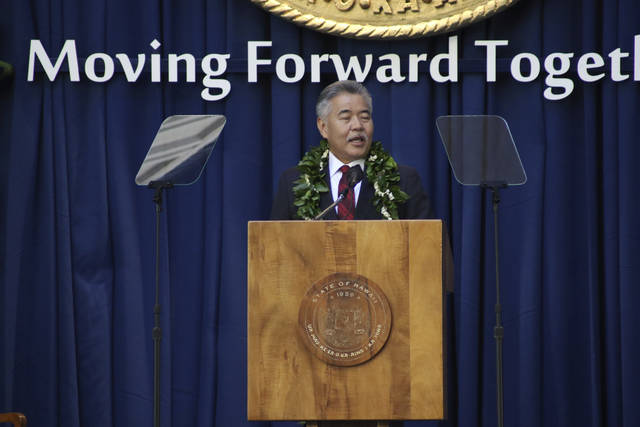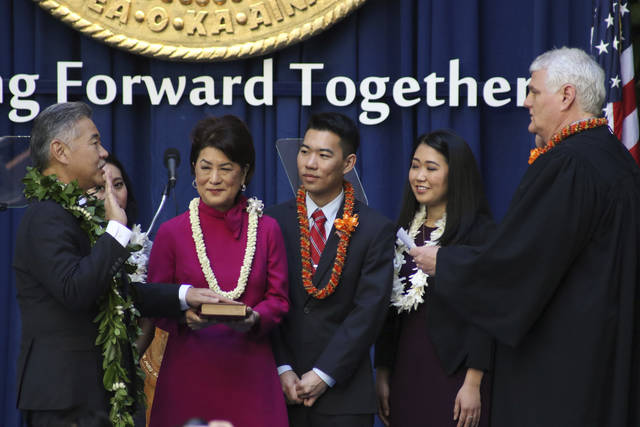HONOLULU — Gov. David Ige took the oath of office Monday for a second term as Hawaii’s governor, saying this generation’s legacy will rest on how well it prepares children for a technology-driven future.
Ige also said in his inaugural address that Hawaii must find new economic resources just as it did 50 years ago when it faced the decline of sugar and pineapple plantations.
The tourism industry has served Hawaii well, he said, but he believes the next great economic transition will be driven by technology.
The governor said technology means Hawaii’s geographic isolation will no longer be a “deal breaker” for growth.
“Our legacy will rest on how well we meet the challenges of the 21st century and how well we begin to transform our economy,” the governor told the crowd gathered in the Hawaii State Capitol rotunda.
The governor will face tough challenges in the next four years, including addressing the state’s chronic housing and teacher shortages.
He’ll be working closely with Lt. Gov. Josh Green, an emergency room doctor from the Big Island who was sworn in for his first term.
Green has vowed to focus his attention on helping the homeless.
Ige told reporters after the inaugural ceremony that he doesn’t believe he will have a harder time during his second term because so many legislative leaders sided with his opponent during the Democratic Party’s primary election.
“I’ve always felt that as long as you have the people’s priorities in mind, everyone will fall in line,” he said.
The governor defeated U.S. Rep. Colleen Hanabusa in the primary. The Senate president, House speaker and finance committee chairs supported Hanabusa’s candidacy.
Ige defeated Republican former state Rep. Andria Tupola in the Nov. 6 election.
Ige got some of his biggest applause of the day when he made a point of contrasting Hawaii with policies of the Trump administration.
“There are some who talk about making America great again, but who do not understand the source of its greatness: its broad and diverse peoples,” the governor said to cheers and whistles from the inaugural audience.
The governor touted progress he’s made on housing, noting his administration is on track to exceed its goal of helping build 10,000 affordable housing units by 2020.
Yet he acknowledged the difficulties ahead, noting “no matter how many homes we build, it may never be enough.”
The state predicted in 2015 that population growth will drive the need for about 65,000 additional housing units by 2025.
“We’re talking about someone’s son or daughter who decides to move to the mainland because they can’t afford a home here,” Ige said.
Hawaii also faces persistent teacher shortages.
The Hawaii State Teachers Association points out Hawaii public schools have 1,000 teacher vacancies.
Only 51 percent of teachers hired five years ago were still teaching at Hawaii schools this year, as teacher retention continues to decline. The figure is down from 54 percent last year.
The governor told reporters that technology to modernize the state’s tax collection systems will help the state collect more taxes. He says this may generate funds for public education.
The Hawaii Emergency Management Agency cancelled a monthly test so sirens wouldn’t go off during the ceremony. But it went ahead with broadcast alert tests, which meant those watching on television had their viewing interrupted.



